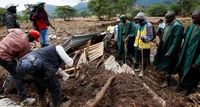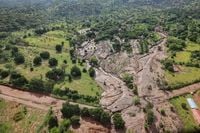At least 21 people have been confirmed dead and more than 30 remain missing after a devastating landslide struck Elgeyo Marakwet County in western Kenya, authorities reported on Saturday. The disaster, which unfolded on November 1, 2025, was triggered by relentless heavy rains that battered the region, leading to widespread destruction and a frantic search for survivors.
According to Xinhua News, the tragedy has left the community reeling as families anxiously await news of their missing loved ones. The landslide, which primarily affected Marakwet East in Elgeyo Marakwet County, has been described by officials as one of the deadliest natural disasters to hit the area in recent years.
Kenya’s Interior Minister, Kipchumba Murkomen, took to social media to update the nation on the unfolding crisis. He confirmed the grim toll: “More than 30 people were reported missing by their families in the tragedy that struck the Marakwet East County.” The minister’s words echoed the growing concern among local residents, many of whom have been left homeless or separated from family members in the chaos.
The rescue operation, which began in earnest on the morning of November 2 after being paused overnight due to treacherous conditions, has been hampered by the sheer scale of destruction. The Kenyan Red Cross, which is playing a crucial role in coordinating the rescue efforts, reported that the most affected areas remain inaccessible by road. Mudslides and flash floods have rendered key routes impassable, complicating the delivery of aid and the movement of emergency personnel. “The most affected areas are still not accessible by road due to mudslides and flash floods,” the organization noted, underscoring the logistical challenges facing first responders.
As the search for survivors continues, the toll of the disaster extends beyond those killed and missing. Approximately 25 people sustained serious injuries in the landslide and were airlifted to the city of Eldoret for advanced medical treatment, News Arena Network reported. Others with minor injuries were treated locally, but the strain on medical resources has been significant.
Efforts to locate the missing have been bolstered by the deployment of military and police helicopters, a measure intended to intensify the search and provide much-needed logistical support. The air support has proven vital given the destruction of civil and government infrastructure, including key road networks. The landslide’s impact on transportation has not only hindered rescue operations but also complicated the delivery of relief supplies to those in need.
Authorities have moved swiftly to address the immediate needs of survivors. Relief items are being distributed to the victims, and plans are underway to restore the damaged road network. Minister Murkomen urged residents living near seasonal rivers and in areas hit by the landslide to relocate to safer ground, warning that further instability could pose additional risks. “I urge people living near seasonal rivers and areas that experienced landslides last night to move to safer ground,” Murkomen wrote in a public statement.
The landslide in Kenya is the latest in a series of weather-related disasters to strike the country in recent years. Kenya is no stranger to floods, with several major incidents recorded over the past decade that have caused hundreds of deaths and widespread destruction. This latest tragedy has reignited concerns about the country’s vulnerability to extreme weather events and the broader impact of climate change.
Experts have pointed to the intensification of floods and landslides across Kenya and other countries as evidence of a changing climate. Increased industrial activity and the resultant rise in carbon emissions have been blamed for altering weather patterns, leading to heavier rainfall and more frequent disasters. According to News Arena Network, “Experts have blamed the recent intensification of the floods reported across multiple countries on climate change and the overall increase of carbon emissions in the atmosphere owing to increased industrialised activities.”
For communities in Elgeyo Marakwet and beyond, the immediate focus remains on rescue and recovery. However, the disaster has also sparked calls for long-term solutions to mitigate the risks posed by extreme weather. Improved infrastructure, better early warning systems, and more robust disaster preparedness plans are among the measures being discussed by government officials and humanitarian organizations alike.
The Kenyan Red Cross and other aid agencies have appealed for additional support to help those affected by the landslide. With many families displaced and entire villages cut off from essential services, the road to recovery will be long and arduous. The psychological toll of the disaster is also becoming apparent, as survivors grapple with loss, uncertainty, and the daunting task of rebuilding their lives.
In the aftermath of the landslide, stories of resilience and solidarity have begun to emerge. Local volunteers, alongside professional rescue teams, have worked tirelessly to locate survivors and provide comfort to those in distress. The sense of community, while tested by tragedy, remains strong as neighbors come together to support one another in the face of overwhelming adversity.
The Kenyan government has pledged to continue its efforts to restore normalcy in the affected regions. The restoration of key infrastructure, particularly road networks, is seen as a critical step in enabling both ongoing rescue operations and the eventual delivery of reconstruction aid. Authorities have also promised to review current policies and practices related to disaster management, with an eye toward preventing similar tragedies in the future.
As the rescue mission presses on, the full scale of the disaster is still coming into focus. With over 30 people still unaccounted for, the hope of finding survivors grows fainter with each passing hour. Yet, the determination of rescue teams and the resilience of the local population offer a glimmer of hope amid the devastation.
For now, Kenya mourns the loss of 21 lives and prays for the safe return of those still missing. The landslide in Elgeyo Marakwet County stands as a stark reminder of the country’s vulnerability to natural disasters and the urgent need for comprehensive strategies to address the mounting challenges posed by climate change.





